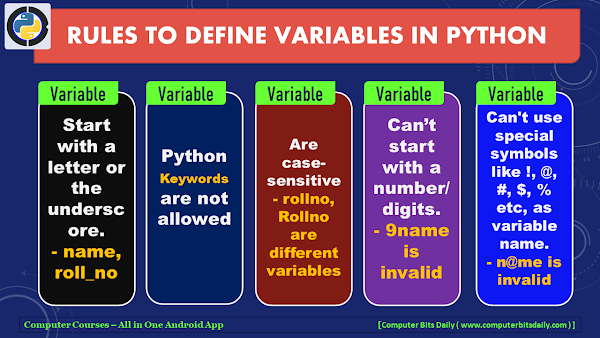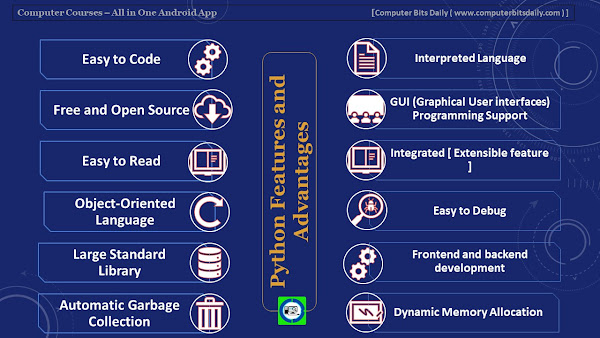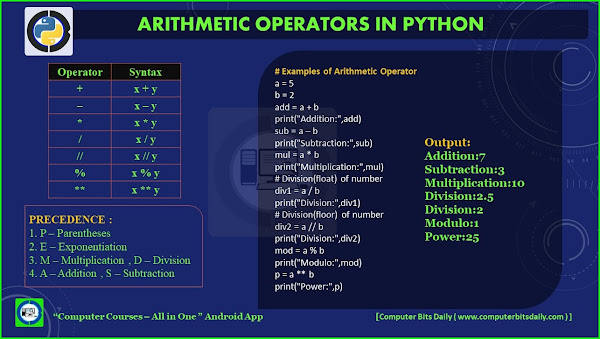What is Python? What are the benefits of using Python
Answer
- Python is a high-level, interpreted, general-purpose programming language.
- It was created by Guido van Rossum in 1991 and further developed by the Python Software Foundation.
- It was created by Guido van Rossum in 1991 and further developed by the Python Software Foundation.
- It is widely used in data science, machine learning and artificial intelligence.
Benefits:
- Python is a general-purpose programming language that emphasizes readability and has an easy-to-learn syntax, which lowers the cost of programme maintenance.
- The language also supports third-party packages that promote modularity and code reuse, is fully open-source, and can be scripted.
- Compared to some other programming languages, Python enables developers to write programmes with fewer lines.
- For all popular platforms, the Python interpreter and the extensive standard library are freely distributable and available in source or binary form.
- Portable and Interactive
Python is used for:
- Web application Development
- System Scripting
- Software Development
- Game Development
- Complex Mathematics
Differentiate between List and Tuple?
Answer
- Lists are Mutable datatype. whereas Tuples are Immutable datatype.
- Lists consume more memory, whereas Tuple consume less memory as compared to the list.
- In List, iterations is Time-consuming. Wheras, Iteration implementation in Tuple is faster compared to the list
- Syntax of list: list = [12, ‘computer’, 50], Syntax of tuple: tup_1 = (12, ‘computer’, 50)
What is the Difference Between a Shallow Copy and Deep Copy?
Answer
- Shallow Copy is a bit-wise copy of an object.
- The copied object created has an exact copy of the values in the original object.
- Shallow copy is faster.
- Shallow Copy reflects changes made to the new/copied object in the original object.
Syntax of Shallow copy
copy.copy(x)
- Deep copy stores copies of the object’s value.
- Deep copy is comparatively slower.
Syntax of Deep copy
- Deep copy doesn’t reflect changes made to the new/copied object in the original object.
copy.deepcopy(x)
What does ‘#’ symbol do in Python?
Answer
- The character "#" is used to comment out the line.
How to Write a code to display the current time?
Answer
c_time= time.localtime(time.time())
print (“Current time is”, c_time)
What is the maximum possible length of an identifier?
What Does the // Operator Do?
What are the applications of Python?
Answer
- Image processing applications.
- GUI based desktop applications.
- Prototyping
- Business and Enterprise applications
- Web and web framework applications
What are the built-in types available in Python?
Python is an interpreted language. Explain.
Answer
Any programming language that isn't machine-level code prior to runtime is an interpreted language.
What are namespaces in Python?
Answer
The name that is given to each object in Python is referred to as a namespace. Variables and functions are the objects.
There 4 types of namespace in python-
Built-in namespace : contain all the built-in objects in python and are available whenever python is running.
Global namespace: For all the objects created at the level of the main program.
Enclosing namespaces: the higher level or outer function.
Local namespaces: the local or inner function.
Are Arguments in Python Passed by Value or by Reference?
Answer
Pass : to provide it an argument.
By reference:When you send a function an argument via reference, it means that the argument is a reference to a variable that is already present in memory.
- In Python, arguments are passed using a reference. As a result, all modifications done inside a function are reflected in the original object.
- Passing immutable arguments to a function, such as integers, strings, or tuples, behaves like call by value. If we pass mutable parameters, it is different.
What are Keywords in Python?
Answer
- Keywords in python are reserved words that have special meaning.
- Keywords are used to define type of variables.
- Keywords cannot be used for variable or function names.
- Keywords: And, Or, Not, If, Elif, Else, For, While, Break, As,
Def,Lambda, Pass, Return, True, False, Try, With, Assert, Class, Continue, Del, Except, Finally
, From,
Global,
Import,
In,
Is,
None,
Nonlocal,
Raise,
Yield








0 Comments